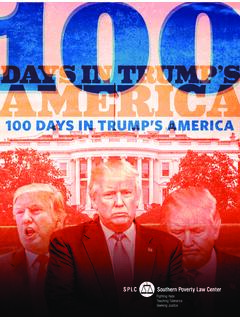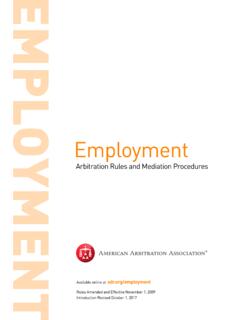Transcription of TEACING TEACHING - Southern Poverty Law Center
1 TEACHING . HARD HISTORY. american SLAVERY. II SOU T H E R N P OV E RT Y L AW C E NT E R // T E AC H I NG H A R D H I STORY // A ME R I CA N S L AV ERY. TEACHING Hard History american SL AVERY. 2 0 18 S O U T H E R N P OV E R T Y L AW C E N T E R. History is not the past. It is the present. We carry our history with us. We are our history. james baldwin, black english: a dishonest argument . 2 SOU T H E R N P OV E RT Y L AW C E NT E R // T E AC H I NG H A R D H I STORY // A ME R I CA N S L AV ERY. CONTENTS. Preface 5. Introduction 7. Executive Summary 9. PART ONE | HOW SLAVERY IS TAUGHT TODAY 12. Key Concepts 16. Table 1 Data Organized by Key Concepts 19. PART TWO | WHY WE MUST CHANGE 20. PART THREE | HOW WE INVESTIGATED THE ISSUE 22. Table 2 High School Senior Survey Responses Summary 24. Table 3 Reported Teacher Practices 26. Table 4 Teacher comfort and support measures 29. Table 5 Textbooks Analyzed 36.
2 Rhode Island's Revisionist History 38. PART FOUR | CONCLUSION AND RECOMMENDATIONS 40. Appendix 1 | Advisory Board Members and Affiliations 42. Appendix 2 | Student Survey Questions 42. Appendix 3 | Textbook Rubric 45. Appendix 4 | Teacher Survey 46. Endnotes 47. Acknowledgments 48. We the People of the United States, in Order to form a more perfect Union, establish Justice, insure domestic Tranquility, provide for the common defence, promote the general Welfare, and secure the Blessings of Liberty to ourselves and our Posterity, do ordain and establish this Constitution for the United States of America. the constitution of the united states 4 SOU T H E R N P OV E RT Y L AW C E NT E R // T E AC H I NG H A R D H I STORY // A ME R I CA N S L AV ERY. Preface H A S A N K WA M E J E F F R I E S. Slavery is hard history. It is hard to compre- In the Preamble to the Constitution, the hend the inhumanity that defined it.
3 It is hard Founding Fathers enumerated the lofty goals to discuss the violence that sustained it. It is of their radical experiment in democracy; racial hard to teach the ideology of white supremacy justice, however, was not included in that list. that justified it. And it is hard to learn about Instead, they embedded protections for slav- those who abided it. ery and the transatlantic slave trade into the We the people have a deep-seated aversion founding document, guaranteeing inequality to hard history because we are uncomfortable for generations to come. To achieve the noble with the implications it raises about the past aims of the nation's architects, we the people as well as the present. have to eliminate racial injustice in the pres- We the people would much rather have the ent. But we cannot do that until we come to Disney version of history, in which villains are terms with racial injustice in our past, begin- easily spotted, suffering never lasts long, heroes ning with slavery.
4 Invariably prevail and life always gets better. It is often said that slavery was our coun- We prefer to pick and choose what aspects of try's original sin, but it is much more than that. the past to hold on to, gladly jettisoning that Slavery is our country's origin. It was respon- which makes us uneasy. We enjoy thinking sible for the growth of the american colonies, about Thomas Jefferson proclaiming, All men transforming them from far-flung, forgotten are created equal. But we are deeply troubled outposts of the British Empire to glimmering by the prospect of the enslaved woman Sally jewels in the crown of England. And slavery was Hemings, who bore him six children, declar- a driving power behind the new nation's ter- ing, Me too.. ritorial expansion and industrial maturation, Literary performer and educator Regie making the United States a powerful force in Gibson had the truth of it when he said, Our the Americas and beyond.
5 Problem as Americans is we actually hate his- Slavery was also our country's Achilles heel, tory. What we love is nostalgia.. responsible for its near undoing. When the But our antipathy for hard history is only Southern states seceded, they did so expressly partly responsible for this sentimental longing to preserve slavery. So wholly dependent were for a fictitious past. It is also propelled by polit- white Southerners on the institution that they ical considerations. In the late 19th and early took up arms against their own to keep African 20th centuries, white Southerners looking to Americans in bondage. They simply could not bolster white supremacy and justify Jim Crow allow a world in which they did not have abso- reimagined the Confederacy as a defender of lute authority to control black labor and to democracy and protector of white womanhood. regulate black behavior. To perpetuate this falsehood, they littered the The central role that slavery played in the country with monuments to the Lost Cause.
6 Development of the United States is beyond Our preference for nostalgia and for a history dispute. And yet, we the people do not like to that never happened is not without conse- talk about slavery, or even think about it, much quence. We miseducate students because of it. less teach it or learn it. The implications of Although we teach them that slavery happened, doing so unnerve us. If the cornerstone of the we fail to provide the detail or historical context Confederacy was slavery, then what does that they need to make sense of its origin, evolu- say about those who revere the people who took tion, demise and legacy. And in some cases, we up arms to keep African Americans in chains? minimize slavery's significance so much that If James Madison, the principal architect of the we render its impact on people and on the Constitution, could hold people in bondage his nation inconsequential.
7 As a result, students entire life, refusing to free a single soul even lack a basic knowledge and understanding of upon his death, then what does that say about the institution, evidenced most glaringly by our nation's founders? About our nation itself? their widespread inability to identify slavery TO LE RAN RG/H AR DH I STORY 5. as the central cause of the Civil War. The intractable nature of racial inequality This is profoundly troubling because is a part of the tragedy that is american slav- american slavery is the key to understanding ery. But the saga of slavery is not exclusively a the complexity of our past. How can we fully story of despair; hard history is not hopeless comprehend the original intent of the Bill of history. Finding the promise and possibil- Rights without acknowledging that its author, ity within this history requires us to consider James Madison, enslaved other people?
8 How the lives of the enslaved on their own terms. can we understand that foundational docu- Trapped in an unimaginable hell, enslaved peo- ment without understanding that its author ple forged unbreakable bonds with one another. was well versed not only in the writings of Indeed, no one knew better the meaning and Greek philosophers and Enlightenment think- importance of family and community than the ers, but also in Virginia's slave code? How can enslaved. They fought back too, in the field and we ignore the influence of that code, that bill in the house, pushing back against enslavers of rights denied, which withheld from African in ways that ranged from feigned ignorance to Americans the very same civil liberties Madison flight and armed rebellion. There is no greater sought to safeguard for white people? hope to be found in american history than in Our discomfort with hard history and our African Americans' resistance to slavery.
9 Fondness for historical fiction also lead us to The Founding Fathers were visionaries, but make bad public policy. We choose to ignore their vision was limited. Slavery blinded them, the fact that when slavery ended, white preventing them from seeing black people as Southerners carried the mindsets of enslavers equals. We the people have the opportunity to with them into the post-emancipation period, broaden the founders' vision, to make racial creating new exploitative labor arrangements equality real. But we can no longer avoid the such as sharecropping, new disenfranchise- most troubling aspects of our past. We have to ment mechanisms including literacy tests and have the courage to teach hard history, begin- new discriminatory social systems, namely ning with slavery. And here's how. Jim Crow. It took African Americans more than a century to eliminate these legal barri- A graduate of Morehouse College ers to equality, but that has not been enough and Duke University, Jeffries to erase race-based disparities in every aspect holds a in american his- of american life, from education and employ- tory with a specialization in ment to wealth and well-being.
10 Public policies African- american history. He is tend to treat this racial inequality as a prod- an Associate Professor of History uct of poor personal decision-making, rather at The Ohio State University and chair of the than acknowledging it as the result of racial- TEACHING Hard History Advisory Board. ized systems and structures that restrict choice and limit opportunity. Understanding american slavery is vital to understanding racial inequality today. The formal and informal barriers to equal rights erected after emancipation, which defined the parameters of the color line for more than a century, were built on a foundation constructed during slavery. Our narrow understanding of the institution, however, prevents us from see- ing this long legacy and leads policymakers to try to fix people instead of addressing the his- torically rooted causes of their problems. 6 SOU T H E R N P OV E RT Y L AW C E NT E R // T E AC H I NG H A R D H I STORY // A ME R I CA N S L AV ERY.







